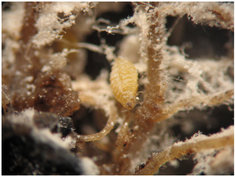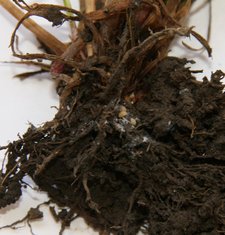Root aphid
Root aphid (RA) has become recognised as a pest relatively recently and the damage it causes is not well understood.
Identification
RA feeds on ryegrass roots sucking sap and producing a white waxy substance. It has a similar appearance to pasture mealybug with which it can be confused. Both pests surround themselves with a white, waxy secretion but RA is found deeper in the soil on roots, whereas mealybug is found in the crown of the plant. RA is also smaller than adult mealybug, yellow-white and oval-shaped.
Adult RA are on average about 2 mm long with two tiny segmented antenna. The aphid body is creamy or pale yellow with tiny legs visible below the body.

Root aphid feeding on perennial
ryegrass roots.
Numbers can be assessed by digging up a spade square of pasture to a depth of 30 cm, breaking the sod apart and looking for the characteristic white waxy exudates. RA numbers tend to vary widely across a paddock. An average of 20 root aphid colonies per spade square may cause a reduction in ryegrass productivity.
RA is not believed to kill plants, but its damage may be additive to that of other pests or stresses such as summer dry conditions. As roots are damaged from feeding, RA will move onto new roots.

Root aphids in a small colony.
Prevention & management
RA can be controlled to a significant level by ryegrass endophytes. AR37 gives very good control of RA, while NEA2 and Standard endophyte provide moderate control. Plants with AR1 or Without endophyte (or with no endophyte) have no RA resistance.

